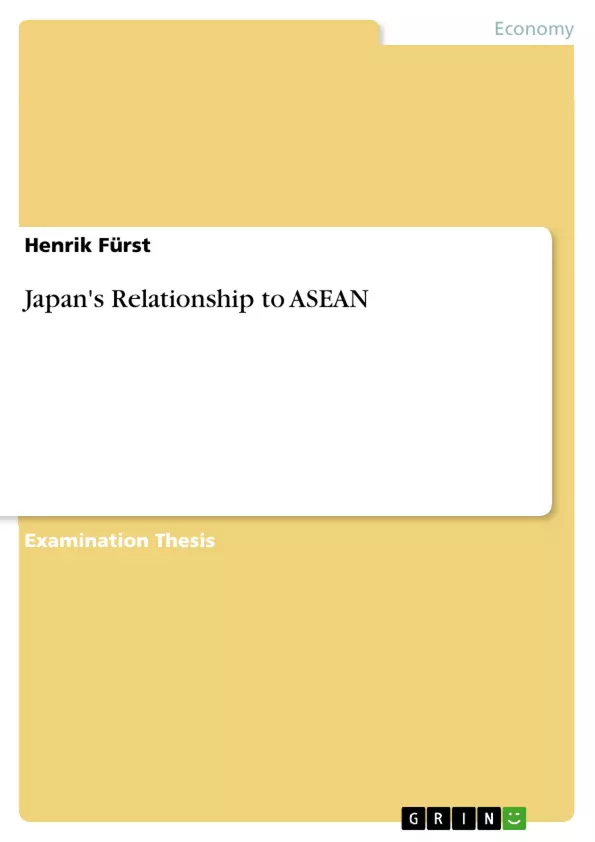The central research question of this paper is as follows: Why is Japan interested in a good relationship to ASEAN? When reading about the historical development and happenings about the ASEAN-Japan relationship, it might look as thoug Japan is more important to the ASEAN than the other way around. However, it is demonstrated here that regional cooperation and integration is mutually beneficient rather than simply a one-way street.
The purpose of this paper is to give the reader an introduction into what exactly the Association of Southeast Asian Nations (ASEAN) is and how their relationship to Japan is important for both sides. The paper will show the reader an "overseas" example of a collaboration between countries that can be considered similar to the European Union (EU).
Inhaltsverzeichnis (Table of Contents)
- Introduction
- Problem Statement and Research Question
- Structure of the Report and Methodology
- Theoretical Background
- Japan's Relationship to ASEAN
- Japan's Political Change: from Bilateral to Multilateral Foreign Policy
- Foreign Policy Used in Economy
- Foreign Policy Used as Security
- Japan's Financial Corporation on the Asia Crisis
- AMF ASEAN Monetary Fund
- The Miyazawa-Initiative
- CMI - The Chiang-Mai-Initiative
- ABMI - The Asian-Bond-Markets-Initiative
- Analysis - Stability in Asia Brings Stability to Japan
- Conclusion
Zielsetzung und Themenschwerpunkte (Objectives and Key Themes)
This paper explores the relationship between Japan and the Association of Southeast Asian Nations (ASEAN). It aims to provide an overview of this important partnership, highlighting its historical development and key aspects. The paper focuses on answering the question of why Japan is interested in a strong relationship with ASEAN, examining the mutual benefits and challenges involved.
- The historical evolution of the ASEAN-Japan relationship
- Japan's strategic shift from bilateral to multilateral foreign policy
- The impact of Japan's financial initiatives on the ASEAN region
- The benefits of regional stability for both Japan and ASEAN
- The role of the ASEAN-Japan Comprehensive Economic Partnership Agreement (AJCEP) in promoting economic cooperation
Zusammenfassung der Kapitel (Chapter Summaries)
The introduction provides context by defining economic integration and outlining the significance of regional agreements like the EU and ASEAN. It also establishes the research question, which focuses on Japan's motivations for its relationship with ASEAN.
The theoretical background chapter delves into the historical development of Japan's relationship with ASEAN. It examines Japan's early support for the ASEAN's economic and social growth, highlighting the key initiatives and agreements that have shaped this partnership. This chapter also discusses Japan's evolving foreign policy, particularly its shift from bilateral to multilateral engagements. Furthermore, it explores the financial assistance provided by Japan during the Asian financial crisis of 1997, outlining specific initiatives such as the AMF, the Miyazawa-Initiative, and the Chiang-Mai-Initiative.
The analysis chapter explores the benefits of regional stability for both Japan and ASEAN. It examines how a strong ASEAN contributes to economic stability in Asia, which directly impacts Japan's own economic security. This chapter also discusses the importance of the ASEAN-Japan Comprehensive Economic Partnership Agreement (AJCEP) in promoting trade, investment, and overall economic cooperation between the two regions.
Schlüsselwörter (Keywords)
This report focuses on ASEAN-Japan relations, economic integration, regional stability, financial initiatives, foreign policy, economic partnership agreements, and the Asian financial crisis.
- Quote paper
- Henrik Fürst (Author), 2014, Japan's Relationship to ASEAN, Munich, GRIN Verlag, https://www.grin.com/document/353529



